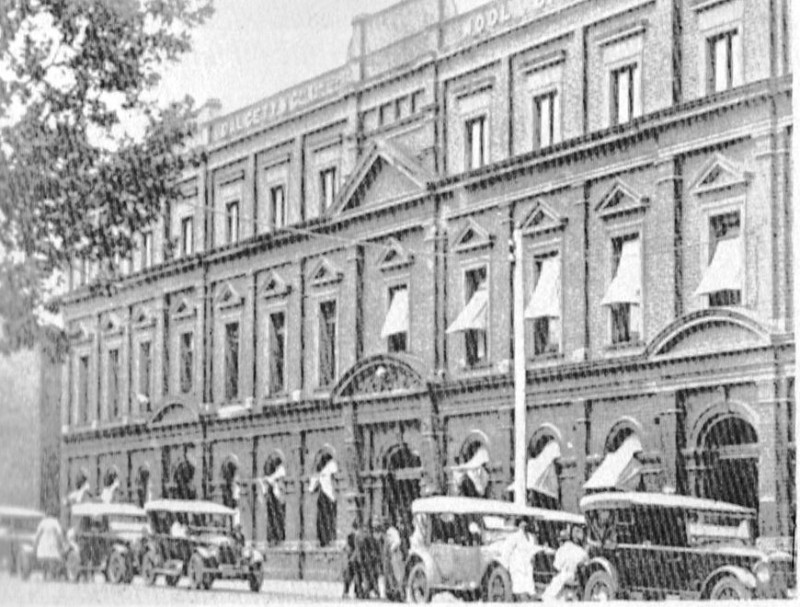
The "Dalgety Wool Store, Gheringhap Street, Geelong. Photo courtesy "The History of Ford Australia".
"Dalgety" Wool Store Assembled Fords
As we discussed on
Ford Australia's First Ford
, the Gheringhap Street Wool Store in Geelong was Ford
Australia's first building used to assemble cars. Although the bodies were
made in Adelaide by Duncan & Fraser Ltd., they were supplied through Duncan
Motors Ltd. as the Ford agents and transported by railway in a "knocked down"
form to Geelong. By October 1925 the bodies were being shipped minus the upholstery
and trimmed in Geelong. Although a cost saving for Ford Australia, in effect it was another
measure that further hindered the Duncan's ability to recoup their tooling and body assembling costs.
Surviving registration records in South Australia indicate that only 726 "Dalgety" assembled Fords were sold in South
Australia from its release on 1st July 1925 to when it was replaced by the "All Steel" bodied "Improved Ford" in April 1926.
Duncan & Fraser Ltd. did continue to build some bodies in very few numbers for Studebaker and some of their other brands, but
this basically signals the end of Duncan & Fraser Limited's body building operations. The cost of French's corporate agenda
was a truly sad way to end some of the most elegant and highest quality body building in Australia.
"Dalgety" Characteristics
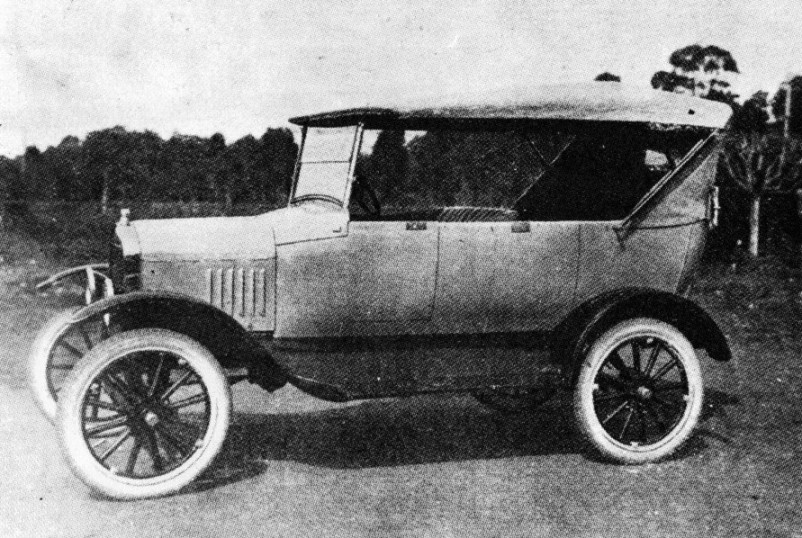
The "Dalgety" Ford; the official press release photo, 1st July 1925.
My first Ford 'T' was a "Dalgety", indeed it was my family's first Ford 'T' bought in the mid 1960's. Unsure of the car's
actual year it was stripped and stored in pieces whilst they restored what they knew to be a 1923 model. Nearly 20 years
later my grandfather and father gave me this car on my 16th birthday in 1983 under the proviso it would be restored.
Hence a life time of
further research seeking and understanding how and why the "Dalgety" Fords are different and truly unique...
Mechanical Characteristics
The chassis and mechanical components
of the "Dalgety" assembled Ford are subtly different to any previous Ford
car sold in South Australia. As the vehicles are RHD, the components had
to come from Canada, but why was the "Dalgety" mechanically different?
Where did the mechanical components come from? These questions have been
around for many years and so far cannot be answered definitively. However,
the mechanical differences found on the "Dalgety" assembled Fords are:
- Brass radiator shell, nickel plated and stamped "Made in Canada" on the face
plate
- Smooth, "narrow" type (non-ribbed) transmission pedals
- Chassis is the "old style" carried over from 1924
- Lowered stub axles
- Shallower curved springs both front and rear
- Pressed (not cast) 16" steering spider
- 5:1 steering gear
- Rectangular 8 gallon fuel tank
- Fixed round lug 23" demountable rims (not Hayes)
- Wooden spoked wheels with a wider steel felloe to fit the new fixed lug rims
Body Characteristics
Just as the chassis and mechanical
components of the "Dalgety" assembled Ford are subtly different so too
is the body. Although the body is extremely narrow compared to any previous
Ford, its seamless construction is very neat, clean and modern for its
time. It is these body features that make the "Dalgety" so distinctive
and easy to recognise:
- Seamless body construction
- Straight body with no "belly out" curve
- Narrow front seat space being a "comfortable squeeze" for 2 adults
- Cowl welded together with tabs
- Door skins wrap completely over the top of the door
- Leather pads on the doors to rest your hand to open the internal door locks
- Internal door hinges i.e. no hinges show on the outside of the body
- Circular cast internally actuated door locks
- Door hinges are pressed metal with an inbuilt check strap to limit opening
- Removable doors without hinge pins (open door 90° and lift up about ¼")
- Wooden 2-piece dashboard painted black fitted with standard, rectangular Ford combination switches
- Curved bottom windscreen frame
- Cast, lower windscreen brackets with a pressed metal strip screwed in place to finish the join in the cowl to dashboard, all painted body colour.
- Combination "Knock Down" front body mounts
- Lowered "One Man" hood with rectangular rear glass fitted in the rear curtain
- Lowered seating following the contours of the rectangular 8 gallon fuel tank
"Dalgety" Roadster
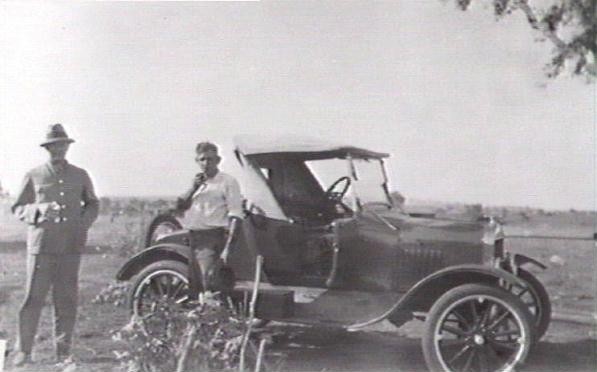
The extremely rare "Dalgety" Ford roadster. Photo courtesy of the Northern Territory Library 10070/80333.
Although the roadster was advertised as being released in July 1925 with the tourer, it wasn't until September
that the first one arrived in South Australia and in the showroom of Duncan Motors Ltd. I have included the best photo I
have so far of this extremely rare variation of the
"Dalgety" body. Surprisingly it came from a collection in the Northern Territory.
This author does not know of any original roadsters that have survived. If anybody has any more information or photos please feel free to contact me as I would love to hear from you...

An Original "Dalgety" Survivor
Every once in a while the stars in the universe align and I was lucky enough to be in the right place at the right time with
a camera. The feature car, engine C585500 was assembled in the height of full production in October 1925. She is an original
"Dalgety" assembled Ford still in magnificent condition complete
with some of the original trim. Although now painted red, it is a superb, surviving example of "Ford Australia's First
Ford". Let's have a good look at C585500 in greater detail...
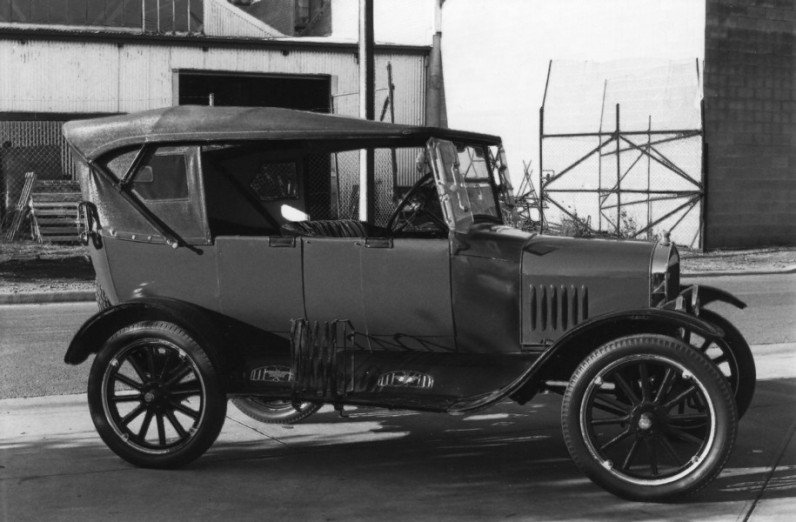
Driver's Side View
The neat, seamless, clean lines of the car can be clearly seen.
The characteristic "small" clearance gap between the wheels and the
mudguards, a combination of the lowered stub axles and shallower curved
springs visibly lowered the chassis about 3". This coupled with a
shortened windscreen and a low "One Man" hood allows a "Dalgety" Ford to stand only 6' 8" tall.
The windscreen deflectors, running board luggage rack and nickel plated kick plates are all
accessories.
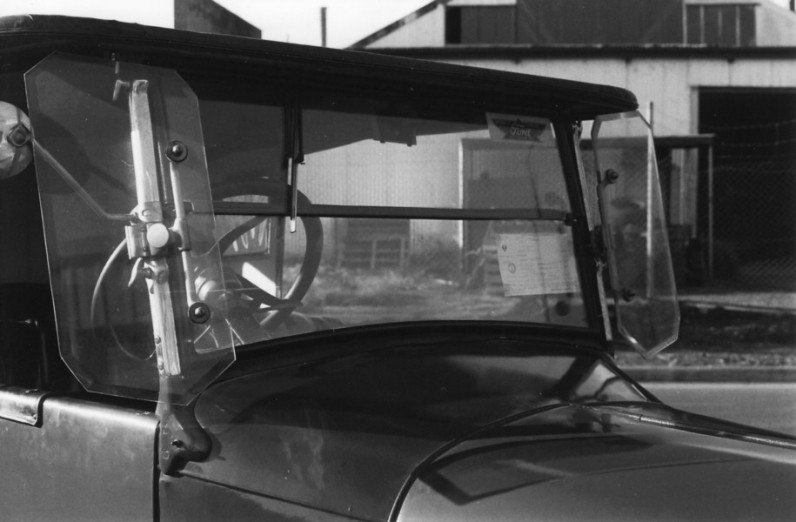
Windscreen Detail
The windscreen has relative short stanchions compared to other years.
The windscreen is split into 2 pieces, both hinged
at the top of each section. The bottom screen is curved to mirror the profile curve of the cowl. It is fitted with a single
piece of 1" flap of rubber to seal against the weather.
The brackets are cast and fit directly onto the body with 3 screws per side. Between the cast brackets is a pressed metal strip (not visible in the photo) screwed in place finishing off the join to the welded cowl.
Brackets and strip are painted body colour, the stanchions and windscreen nuts are nickel plated with the windscreen frames painted black.
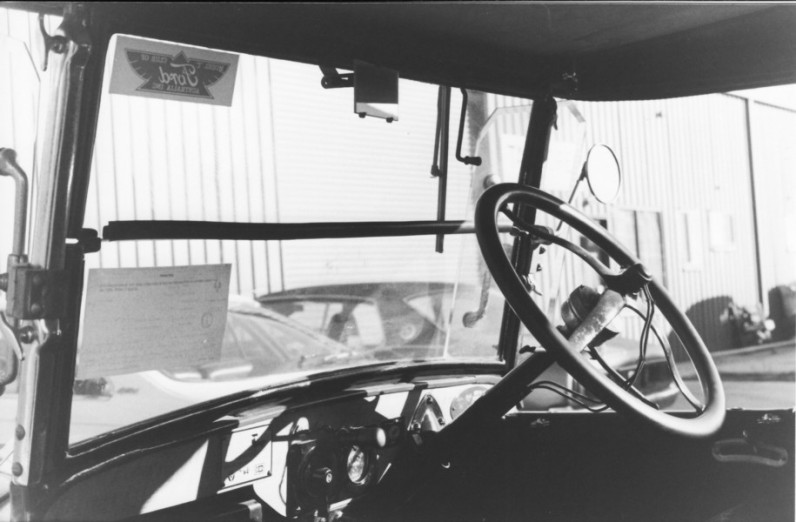
2-Piece Dashboard
The dashboard reverted to a cheap, wooden, 2-piece construction and is painted black. It is joined where the smaller piece
around the switches is screwed to the upper piece. The "Dalgety" is fitted with standard Ford switches and switch plate.
The square rear view vision mirror is genuine Ford and was part of
the car when bought new. The dashboard mounted map light is an accessory.
In South Australia the
"Duncan Motors Ltd." brass Ford dealer's plate was mounted centrally on the passenger side.
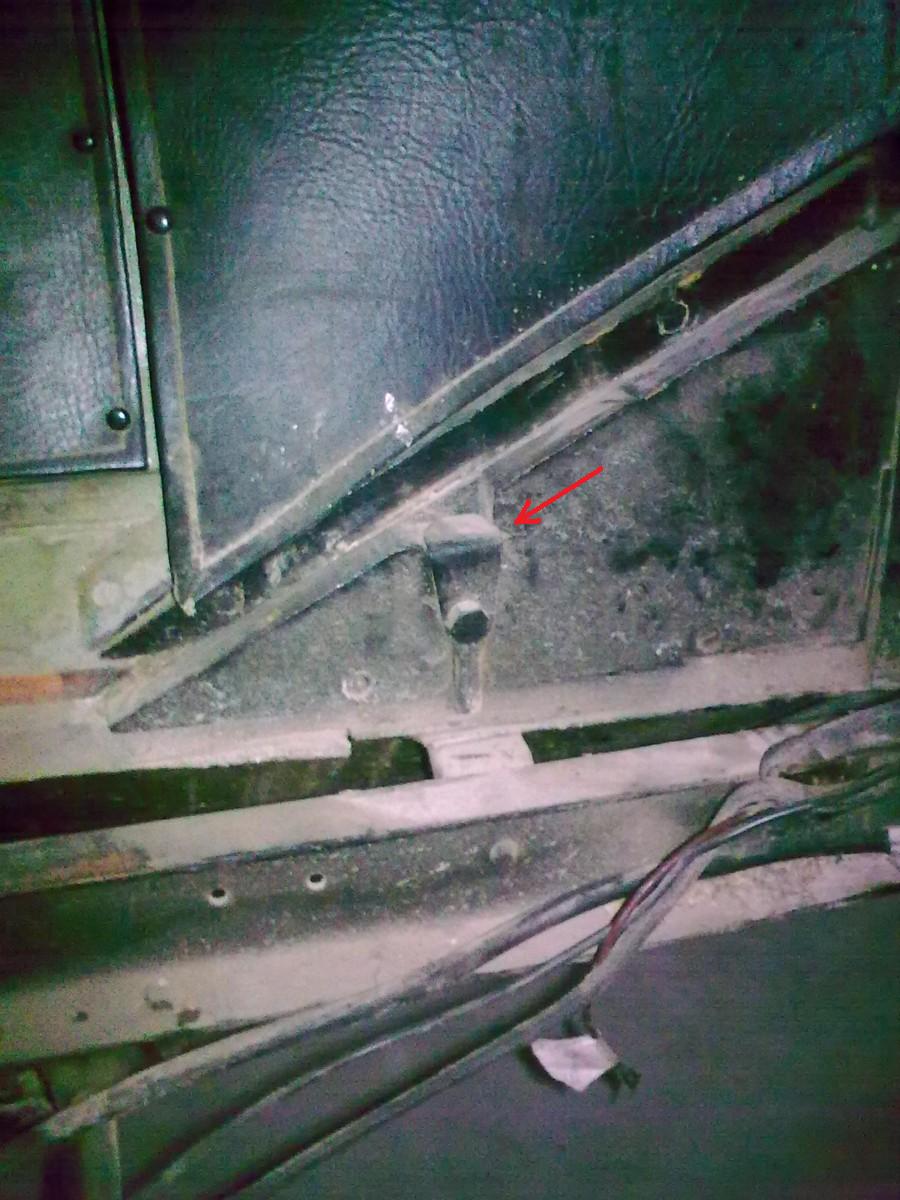
Front Body Mount (from another car)
The Adelaide made front body mount is now made from threaded bar, swaged flat on and forged over at the end to 90°, again peculiar only to the "Dalgety" body.
A "Dalgety" body was constructed by first laying down the main runners as the base of the body. Then the floor board
risers were added bolted to the firewall woodwork, a small cut out was made parallel to the chassis to hold the front body bolt. This in turn was coach screwed from the side and was bolted from underneath during the rest of the body construction process.
At completion, the nut and washer was simply removed from underneath and the front bracket remained bolted to the body due to the coach screw. This enabled full transportation and the mountings remained in place ready for assembly in Geelong. Quite a simple but effective example of South Australian engineering.
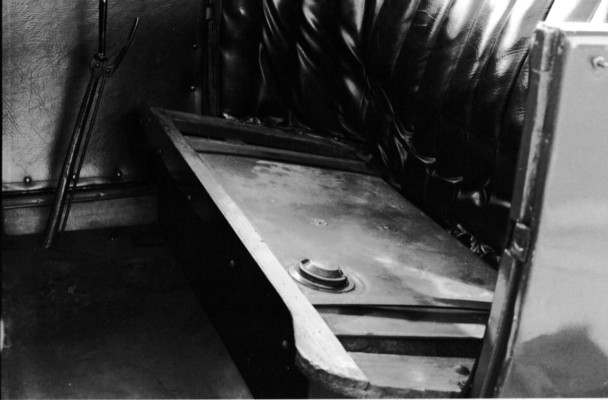
Rectangular Fuel Tank
The now rectangular fuel tank still maintains an 8 Imperial Gallon capacity and was finished in galvanised iron.
Locally made
in Adelaide it was a key feature of the Duncan's strategy ensuring that their body design could only be used. Unlike standard
Ford fuel tanks supplied since 1912, the rectangular tank is sided and non-reversible. The filler cap is on the passenger side.
The brackets were also locally made to suit the rectangular tank and mount using the same bolt holes from the
standard Ford supplied oval fuel tank. The brackets are painted black.
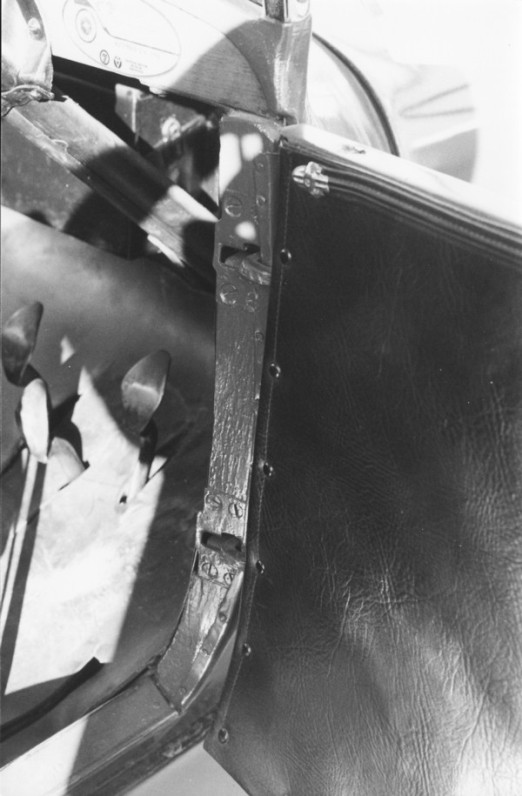
Pressed Door Hinges
The doors hinges are of a pressed construction and now feature an inbuilt check strap with no external hinges or pins.
The doors are now removable by opening fully to 90°, raise the door about ¼" and lift away from the car, both front and rear. This feature now means the doors are made separately on jigs and interchangeable from car to car. A truly remarkable body building achievement years ahead of its time.
Door Construction
The door skin wraps over the top of the door. The door trim is square panel fixed flush to the inside of the door.
This particular car is fitted with inserts in the top of the doors allowing "fixed post"
side curtains to be fitted. This type of side curtain can be opened with the door and was a huge advancement, although
an accessory added outside of the showroom.
Smooth Transmission Pedals
The narrow type "smooth" transmission pedals can be seen. Unusually the "Dalgety" Ford is the only model with these pedals.
The pedals and handbrake are painted black.
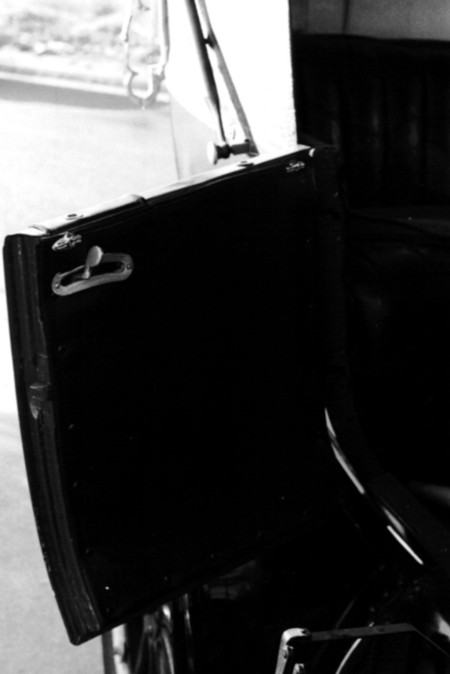
Rear Door
The distinctive cast round door lock is only used on this model and a feature of the "Dalgety" body.
A piece of black leather 4" wide covers the top of the door in this postion to minimise wear on the paintwork. This is a feature of Duncan Motors Ltd. and is another carry over design first introduced on their bodies in 1921.
The pressed aluminium "banana" shaped piece around the handle is another carry over the the Duncan's previous body used since 1921. Held by 2 screws it neatens the operating aperture for the door lock in the door trim.
The wrap over door skin is also plainly visible. This method of construction, another Duncan Motors Ltd. carry over from their previous body, eliminates the requirement of a finishing piece on top of any of the doors.
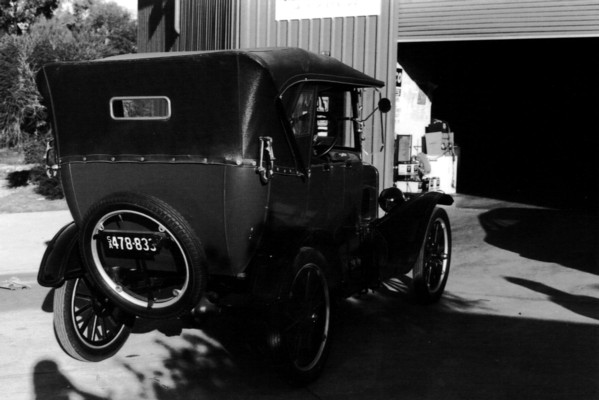
Rear View
In this view we continue to see the seamless type of construction. The rear quarter panels are pressed in a single
piece adding strength to the body's framework.
The shallow profile of the hood can be seen complimenting the overall reduced height of the car. At around 6' 8" the
"Dalgety" is the lowest of all of the Duncan & Fraser Ltd. built Ford bodies.
The "rectangular" glass window in the rear curtain is a carry over from the Duncan Motors Ltd. 1924 model and is
correct for a "Dalgety".
The spare wheel carrier is also a carry over from Duncan Motors Ltd. from when it was first introduced in 1921. It was utilised by the Duncan's in their 1921 design and was carried over to the "Dalgety". Still painted black, the carrier comes complete with integral electric taillight and number plate bracket, rim latch with a hole so it can be secured if so required. The fixed lug spare rim can also be seen.
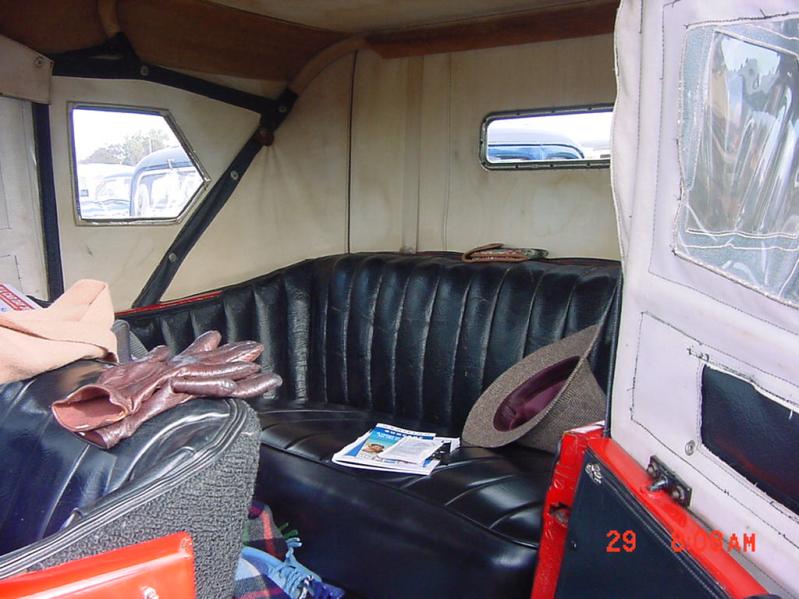
Rear Trim
The original trim from this car. "Antique Grey" (very close to black) in colour, the back rests are parallel pleated and made in 3 pieces; two side panels
and the back panel.
The seat swabs are pleated on top but plain around the edges; similar the reupholstered swabs that can be seen in the photo. A single plate painted black is screwed to the seat frame holding the swabs in postion preventing them from sliding forward.
The inside of the rear curtain and hood can also be seen.
An accessory "fixed post" side curtain can also be seen in the open position. The design of the side curtain windows
with the "narrow" window is correct. Most modern restorations increase the size of these windows for obvious safety reasons.
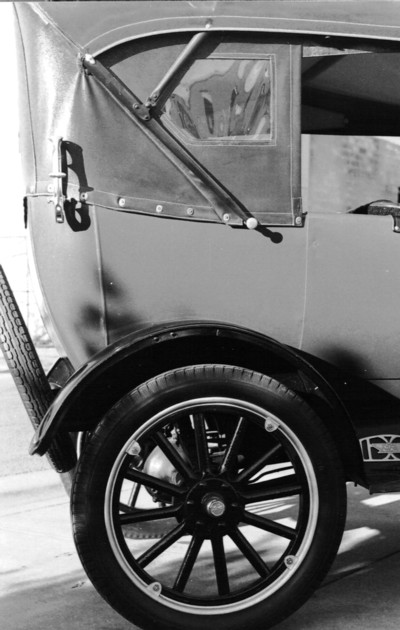
Fixed Lug Demountable Rims
The wheels continue to be 23" fitted with 30 x 3½ beaded edge tyres, but the rims now have a rounded fixed lug. The wheel nuts are different and have a taper on the bottom thus locating and securing the rim at the same time.
The wheel is subtly different suit these rims. The spokes are an eighth of an inch shorter than other Ford demountable wheels and the felloe is ¼" wider on the rear lip.
No part of these wheels are interchangeable with previous Ford supplied
demountable wheels. Once again, the "Dalgety" Ford is unusual as the only model with these wheels and rims.The wheels are painted black. The rims are cadmium plated.
450 x 21" Demountable Rims
Sometime in early 1926 the "Dalgety" changed and was assembled with 21" beaded edge rims. Not long after these were changed to well type rims. It not known how many of each were made or supplied. As we were still selling September and October
assembled "Dalgety" Fords as late as April 1926, very few examples of the later wheels arrived in South Australia and sadly even less have survived.
Hood Mechanism
The "One Man" hood has enclosed hood bows and is painted black. The hood clamps are standard Ford parts and nickel plated.
Another Original "Dalgety" Survivor, Mr. Garard's Car
Peterborough in South Australia's mid north was an important town as it sits on the intersection of the East-West railway linking Port Pirie and Broken Hill, and the North-South railway linking Adelaide eventually to Alice Springs via Quorn, both on the old narrow 3' 6" gauge. Always needing Ford service, William Smith became the local
Ford Dealer
in December 1922.
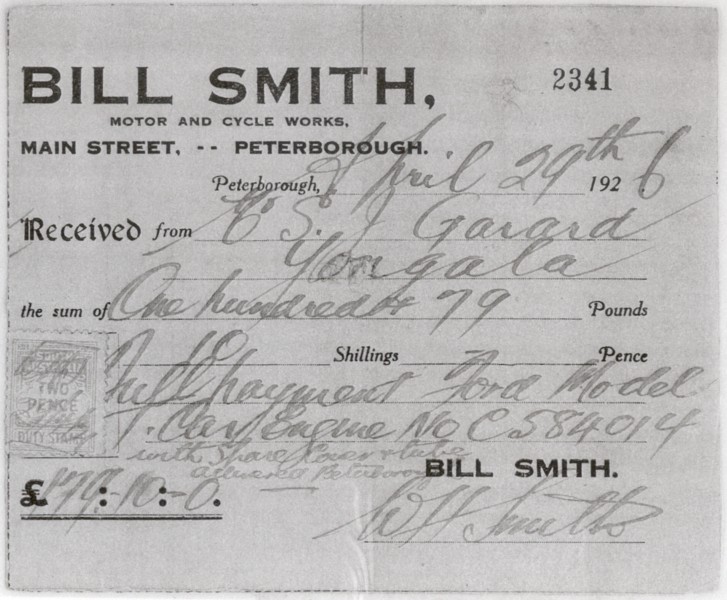
Original receipt dated 29th April, 1926. Photo courtesy Albert Jones. Scanned by Adam Jones.
Mr. S.J. Garard of Yongala purchased his "Dalgety" C584014 from Smith's
of Peterborough on 29th April 1926. Although assembled in September
1925, it took over 6 months to sell. The sale of this car is more
evidence of the poor state of affairs within Ford Australia and selling
their cars in this time period.
Interestingly Mr. Garard paid the new reduced 1926 price of £179/10/- and not the advertised price of £185 when released the year before. The prices were dropped to move obsolete stock.
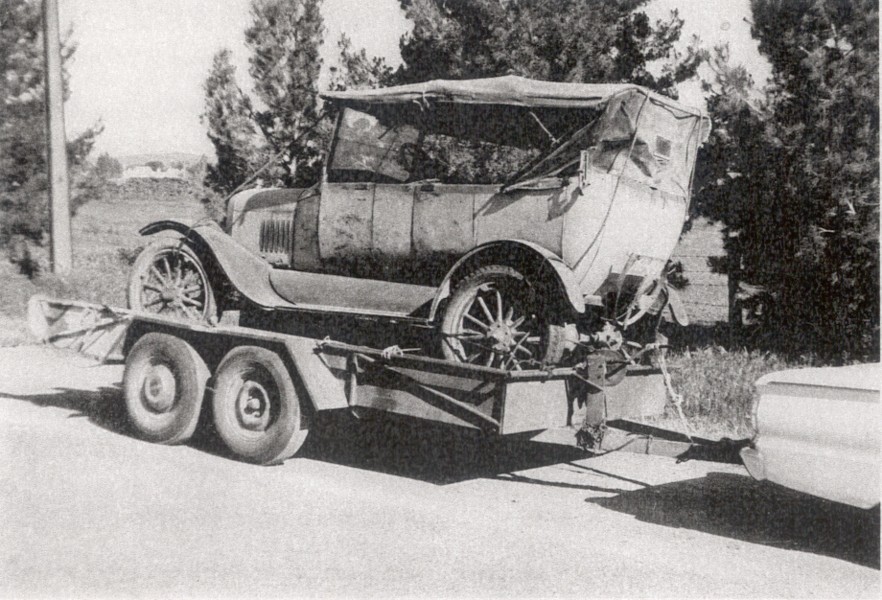
Mr. Garard's car, C584014 as found. Photo courtesy Albert Jones. Scanned by Adam Jones.
The "Yongala" car C584014 as found,
on the trailer and ready to see her new home. This "Dalgety" Ford
was complete when found and has been superbly restored by Albert Jones
of Adelaide, South Australia.
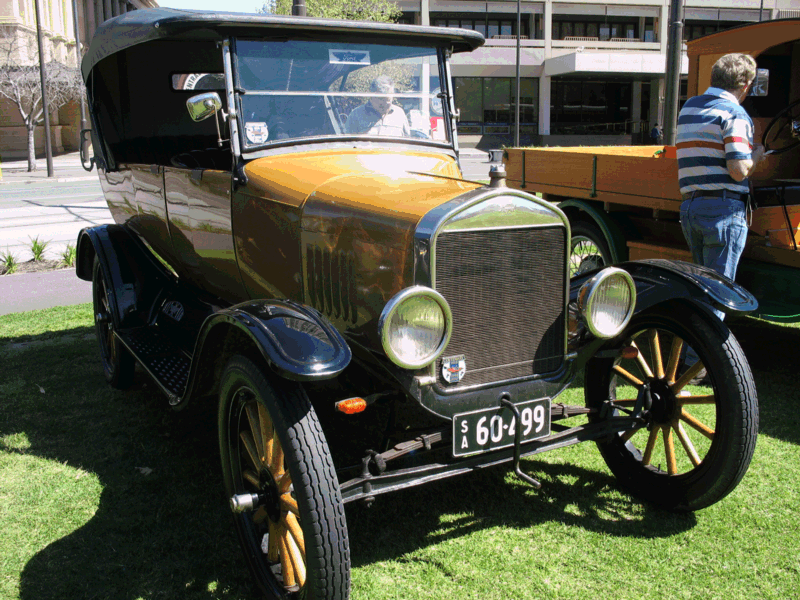 Mr. Garard's'
car today. Photo courtesy Chantrell Family.
Albert Jones has had this car for over 25 years and is a lovely example of a surviving "Dalgety" Ford. Albert
has rallied the car extensively. This photo was taken at the gathering of Fords in Victoria Square, Adelaide in 2008 to meet some other 'T's being driven around Australia and another group driving across from Perth a part of the 100th Anniversary of the Ford 'T'. Later in 2008 it took part in the 100th Anniversary National Ford 'T' Rally at Echuca.
Surviving "Dalgety" Gallery
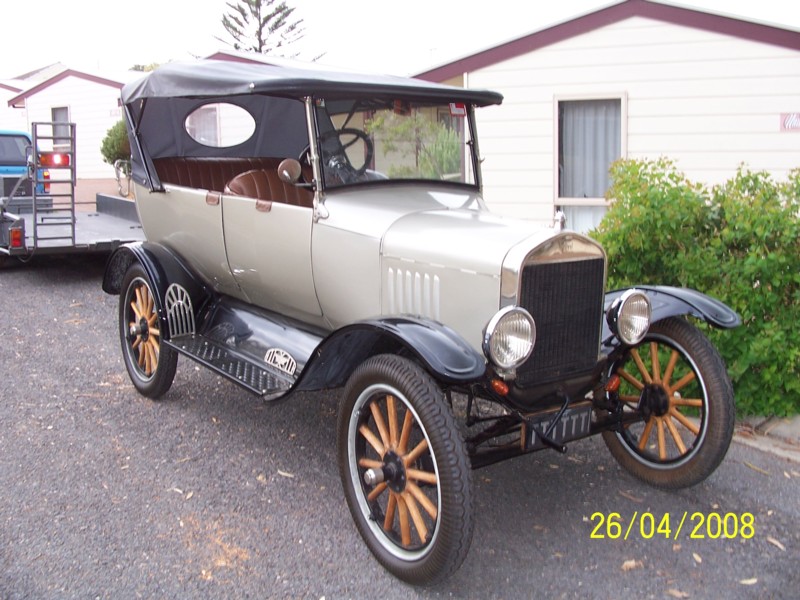
John Allan, S.A.
John bought this car complete and drove her home in 2008. Painted a silver grey colour, it is another fine example of a "Dalgety" Ford. This car is currently for sale.
Photo courtesy of Adam Jones.
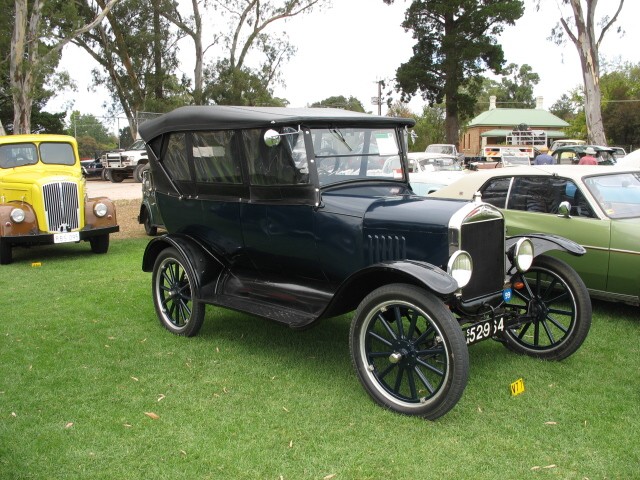
Colin Altmann, S.A.
This photo was taken at the "Power of the Past" at Mount Barker in 2007. It is a beautiful example of another surviving
"Dalgety" Ford.
Photo courtesy of Chantrell Family.
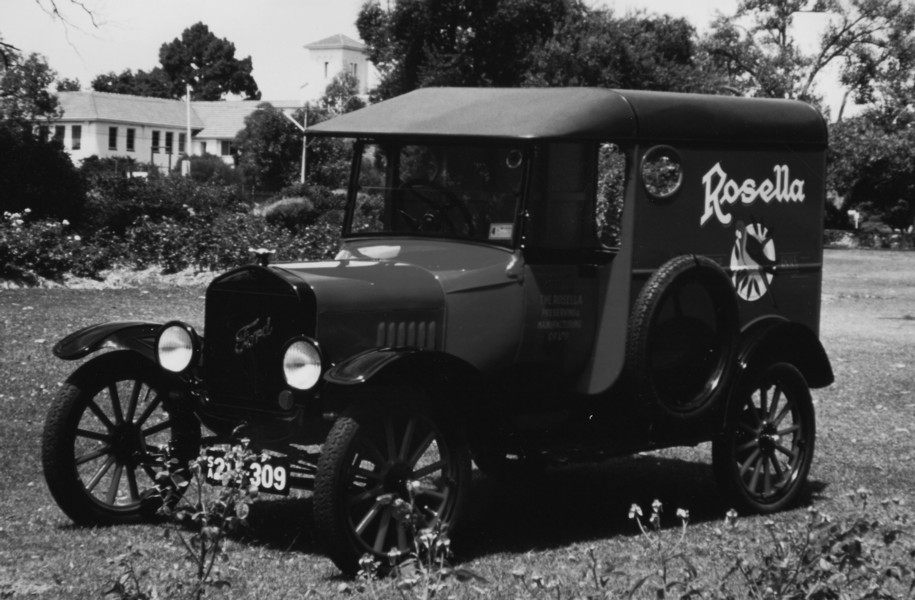
Unilever Foods, VIC.
The Chantrell's first 'T'; my beloved "Rosella" van C584178. "Rosie" was restored in 1988 and featured a Manchester styled
van body. Sold in 1994 she is now owned by Unilever Foods in Melbourne, Victoria.
Photo courtesy of Chantrell Family.
Can You Help?
Do you own a "Dalgety" Ford? Do you want a photo of your "Dalgety" in this gallery? Does anybody in the SA Ford 'T' Club have a
good photo of Max Sierp's or Paul Weidenbech's 1925 tourers?
Do you have a relative that was involved in manufacturing, selling or servicing "Dalgety" assembled Ford cars? Have
you an old photograph(s) hidden away in those old, dusty family albums? Do you have any original receipts?
If the answer is 'yes' to any of these questions I would love to hear from you.


| | |




















